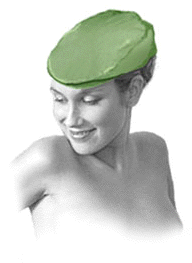...Best of Sicily presents... Best of Sicily Magazine. ... Dedicated to Sicilian art, culture, history, people, places and all things Sicilian. |
by Antonella Gallo | ||
Magazine Index Best of Sicily Arts & Culture Fashion Food & Wine History & Society About Us Travel Faqs Contact Map of Sicily |
The tweed hunting caps were a novelty in Sicily. In that era traditional country costume was in a state of evolution, with the Sicilian aristocracy beginning to imitate the British, whereas previously the Spanish and French modes of dress were more influential. Tweed ushered in a style that emphasized a relaxed image, placing the hunter's sartorial patterns in harmony with his environment. No more bright, eye-catching colors in the woods and bush. The caps were part of this trend. Before long, Sicilian peasants were imitating the English country gentleman's style, at least where the caps were concerned. Called the coppola, it was a reasonably faithful imitation of the British cap, though its proportions were often altered slightly. The coppola had the virtue of being inexpensive and easy to make. It offered perfect protection from the Sicilian sunshine and, as a form of conspicuous consumption, albeit economical, it allowed simple folk to wear what was viewed as a luxury item. Aristocrats, however, rarely wore coppolas. This eventually prompted the barons and their agents to refer to any submissive worker as "una buona coppola," or "a good coppola." In the latter nineteenth century, as the rural Mafia gradually imposed a degree of control over the countryside, the Mafiosi used the same phrase in referring to citizens unlikely to interfere in the organization's criminal activities. In the 1990s, a number of Italian designers revived the style, which had originated in the 1960s, of colorful coppolas for young people in anything but brownish tweeds and grayish patterns. Claiming that the Sicilian promotion of these stylish caps would strike a blow at what was viewed as a Mafia stereotype of the coppola as a symbol of conformity, or even tacit acceptance of Mafia power, politicians sought and obtained European Union funding of coppola-linked "Mafia awareness" programs. The very important fact that wearing a certain kind of hat does not make one a Mafioso was conveniently overlooked. However, the "movement" did at least support the creation of some attractive hats, and a pretty head sporting a coppola is about as far as you could possibly get from the traditional stereotype of the rustic Sicilian Mafioso. A social program to help young women at risk for substance abuse or organized crime has been established in San Giuseppe Jato (near Palermo), sponsored in part by the health ministry. Among its goals is teaching practical work-related skills, including the making of coppolas, and other fashion-related professions. As a footnote, it is worth mentioning that in the twentieth century a cap very similar to the coppola became popular among drivers (chauffeurs) and even golfers. Each style owes its origin to the British hunting tradition. As an older generation passes on, Sicily's traditional tweed coppola is waning in popularity. The brightly colored "fun" coppola may be the wave of the future. Editor's Note: Coppola vendors are indicated in the "Fashion" section of Best of Sicily's links page. About the Author: Antonella Gallo, who teaches art in Rome, has written numerous articles on arts and artists for Best of Sicily. | |
Top of Page |
 It's never been so "sexy." The Sicilian coppola cap
is a variation of the English gamekeeper's cap introduced in Sicily around
1800 when Ferdinando I, King of Naples and Sicily, left Naples for Palermo
in the face of Napoleon's invasion of southern Italy. What actually happened
is that tens of thousands of British troops were stationed in Sicily to
protect the island from a possible French invasion. This was more likely
than one might at first think, as the Knights of Malta had recently been expelled
from their nearby island following little more than token resistance against the French. An
avid hunter, Ferdinando spent much time at his hunting grounds around Palermo,
particularly the Favorita Reserve, beneath Mount Pellegrino near the present
stadium, and Ficuzza, near Corleone. He was usually accompanied by a number
of British diplomats, military officers and business men. Britain's interest in protecting Sicily was more than geopolitically strategic. Sicilian sulphur
was as important to Britain's military might as to its industrial revolution.
Dressed in tweed, the keepers administered the royal hunts of boar, pheasant,
hare, wild cat and the occasional deer.
It's never been so "sexy." The Sicilian coppola cap
is a variation of the English gamekeeper's cap introduced in Sicily around
1800 when Ferdinando I, King of Naples and Sicily, left Naples for Palermo
in the face of Napoleon's invasion of southern Italy. What actually happened
is that tens of thousands of British troops were stationed in Sicily to
protect the island from a possible French invasion. This was more likely
than one might at first think, as the Knights of Malta had recently been expelled
from their nearby island following little more than token resistance against the French. An
avid hunter, Ferdinando spent much time at his hunting grounds around Palermo,
particularly the Favorita Reserve, beneath Mount Pellegrino near the present
stadium, and Ficuzza, near Corleone. He was usually accompanied by a number
of British diplomats, military officers and business men. Britain's interest in protecting Sicily was more than geopolitically strategic. Sicilian sulphur
was as important to Britain's military might as to its industrial revolution.
Dressed in tweed, the keepers administered the royal hunts of boar, pheasant,
hare, wild cat and the occasional deer.